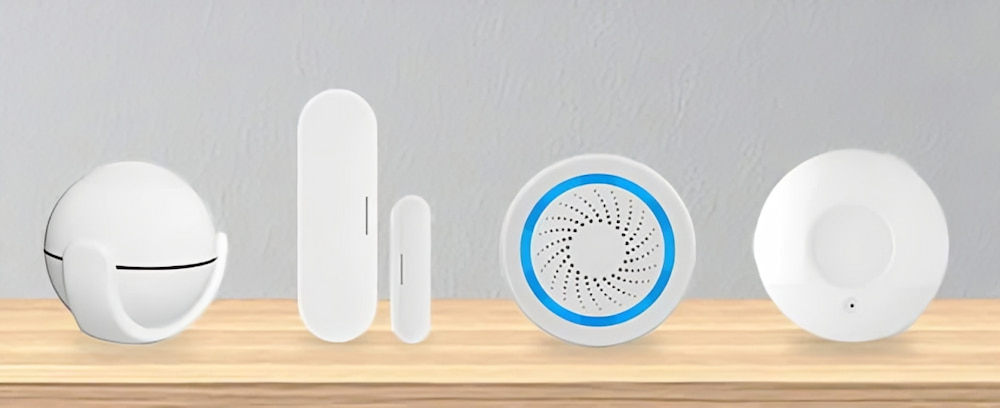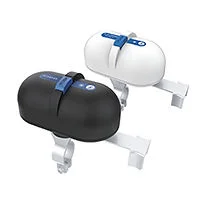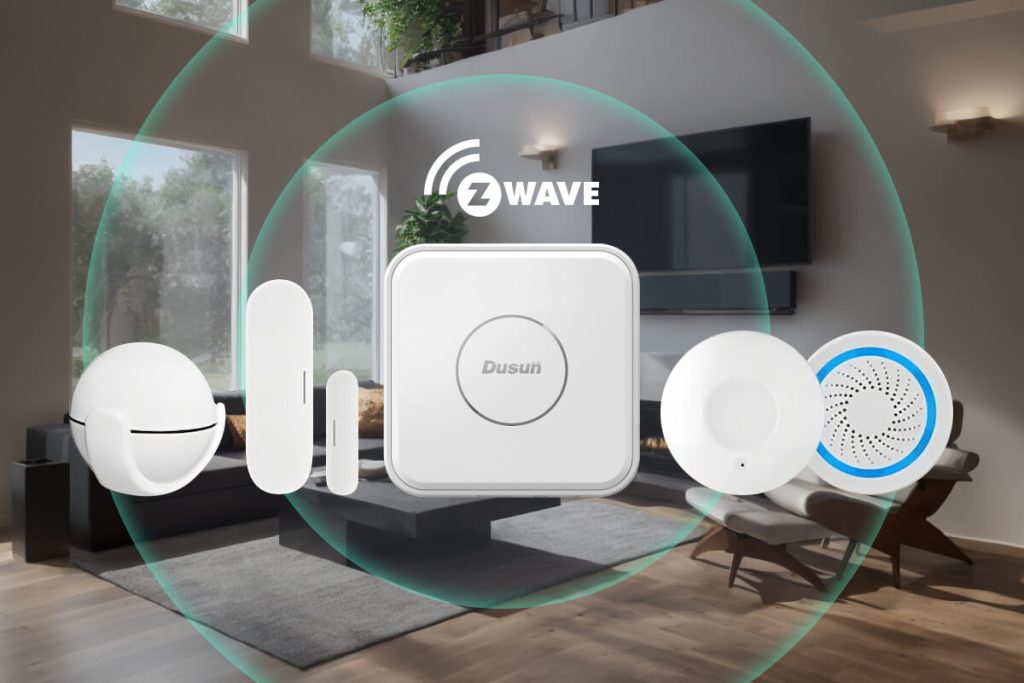Z-Wave 800 series is the latest version of this wireless protocol, with the two previous ones being Z-Wave 500 and Z-Wave 700. This wireless IoT mesh communication protocol was published in 2021 to develop exceptional smart home experiences.
Z-Wave 800 has several advantages over its predecessors, and we’ll look at the areas it excels and which Z-Wave 800 series hardware you need to build your smart home solutions. Let’s get right into it!
Why Z-Wave 800 Series?
The Z-Wave 800 series represents the latest and most advanced generation of the Z-Wave wireless protocol, offering several key advantages over previous versions. The Z-Wave 800 series’ combination of extended range, improved battery life, enhanced security, faster processing, and simplified development make it the optimal choice for a wide range of smart home applications, including IoT gateway, lighting, thermostats, door locks, sensors, and more.
Low Power (Long Battery Life)
This series reduces the transmission current by up to 42% and receiver current by up to 600% compared to the 700 series. Using a coin cell, you can expect a 10-year battery life on sensors and other end nodes. Additionally, Silicon Labs introduced LESENSE plus ACMP, which detects low power switching and allows other associated battery life improvements.
Extended Wireless Range
Z-Wave 800 can achieve a range of up to 2400 meters or 1.5 miles, which is an increase of 50% compared to its predecessor (up to 1600 meters). Therefore, the smart home solution network will need fewer gateways and connect to sub-devices on all floors. If the walls are too many, you can mesh the network to reach all rooms.
Security (S2 and Secure Vault)
S2 is standard and present even in Z-Wave 500 to protect against security threats. But Secure Vault is new, and Z-Wave 800 has it. It is Silicon Lab’s industry-leading security suite for securing sub-GHz wireless communication.
The suite protects the connected devices, IP, customers, user data, and backend services against emerging threats.
Silicon Labs is also continuously developing these security features to comply with the latest IoT security regulations and eliminate device-maker risks and investments.
Fast Processing
Z-Wave 800 SoCs feature a 32-bit 78 MHz ARM Cortex-M33 that is significantly faster than the 39 MHz ARM Cortex M4 used in the previous generation.
Z-Wave 500 vs. 700 vs. 800 Comparison
Here’s a quick comparison of the differences between Z-Wave 500, Z-Wave 700, and Z-Wave 800.
| Z-Wave 500 | Z-Wave 700 | Z-Wave 800 | |
| Wireless Range | 600 meters | 1 mile (1600 meters) | 1.5 miles (2400 meters) |
| Battery Life | Up to 1.5 years | Up to 10 years | Up to 10 years |
| Security | S2 | S2 | S2 and Secure Vault |
| Flash Memory | 128kB | 256kB | 512kB |
| RAM | 16kB | 32kB | 64kB |
| Module Footprint | 8x8mm | 9x9mm | 6.5×6.5mm |
| SoC Footprint | No SoC | 5x5mm | 5x5mm |
| Compatibility | Backward Compatible | Backward Compatible | Backward Compatible |
Z-Wave 500, 700, and 800 series represent progressive enhancements in smart home technology, each improving upon its predecessor in terms of range, energy efficiency, and security. The Z-Wave 500 series, while still widely utilized, offers basic connectivity with moderate power consumption. The 700 series advances this by offering greater transmission distance and improved battery life, making it ideal for more demanding applications. The latest, Z-Wave 800 series, extends these capabilities further with up to 1.5 miles of range, minimal energy usage, and introduces top-tier security features including Secure Vault, suitable for high-security applications like smart locks and comprehensive home automation systems. Each series exemplifies a leap forward in accommodating the growing demands of modern smart homes with enhanced performance and safety features.
Z-Wave 800 Series Devices
Since the Z-Wave 800 series is specifically designed to enhance the smart home experience, it includes this hardware range to achieve that.
Z-Wave Modules
If you are a hardware developer, you can use Z-Wave modules to build smart home devices by interfacing them with sensors to make sub-devices.
As a official partner of Silicon Lab, Dusun support the Z-wave 800 series module – DSM-103 EFR32ZG23. It supports Z-Wave and Z-Wave long range and has a rich interface containing 28 pins (two columns of 14 each).

The module also has two antenna connection methods, the default being an IPEX socket connection, and the second is via an extension to the motherboard through the port.
Similarly, there are two ways to connect to the motherboard: via the motherboard attachment or standard 1.27mm pitch connectors.
The module supports all the global Z-Wave frequency bands, including the popular 868, 906, 916, and 920 MHz frequencies.
For docking support, you can pair this module to any gateway (Dusun or third-party) as per the standard protocol or API. Some of the API content includes:
- Reading sensor data
- Changing device configurations
- Controlling device switches
The module can also provide MQTT for your smart home solution’s gateway to connect to the customer’s platform, enabling them to view the sub-device status and data at any time.
| Product Name | Wireless Devices | Firmware version |
|---|---|---|
| DSM-103-1 | Z-Wave Temperature &humidity sensor | DSM-103_T&H sensor.bin |
| DSM-103-2 | Z-Wave Door/window sensor | DSM-103_Beacon.bin |
| DSM-103-3 | Z-Wave PIR Sensor | DSM-103_ PIR.bin |
| DSM-103-4 | Z-Wave Leakage Sensor | DSM-103_Leakage.bin |
| DSM-103-5 | Z-Wave Plug | DSM-103-Plug.bin |
| DSM-103-6 | Z-Wave Switch(3 gang) | DSM-103-Switch.bin |
| DSM-103-7 | Z-Wave Smoke Sensor | DSM-103-Smoke.bin |
| DSM-103-8 | Z-Wave Emergency button | DSM-103-SOS button.bin |
| DSM-103-9 | Z-Wave RGB lighting | DSM-103-lighting.bin |
| DSM-103-10 | Z-Wave Strip(4 gang) | DSM-103-Strip.bin |
Z-Wave Gateways
A Z-Wave gateway is the heart of the Z-Wave smart home solution, and I recommend looking for a multi-protocol IoT gateway that has all the connectivity options. One example is the DSGW-210 RK3328 Edge Computing Gateway.

- CPU: RK3328 Quad-core Cortex A53;
- OS: Debian 11, Ubuntu 20.04, Android 11, Yotco 4.0 for option;
- RAM: 1GB / 2 GB for option;
- eMMC: 8GB / 16GB / 32 GB for option;
- Support 1 * TF card, up to 128GB;
- Support Bluetooth 5.2, Zigbee 3.0, Z-Wave; 4G LTE CatM1, Cat1, Cat4; Wi-Fi 2.4GHz / 5GHz; Ethernet;
- Lithium back-up battery (5,000 mAh) for option;
This gateway supports up to 40 sub-devices, and you can customize hardware features like EMMC, RAM, CPU, and flash memory to suit the specific smart home solution you want to build for your customers.
Customization doesn’t end there. Dusun gateways are fully programmable down to the firmware (via UART). You have the option of using ready-made or custom-made home automation software, including for the gateway applications that provide local control and automate some functions (edge computing).
If you need a more personalized Z-Wave 800 gateway, we do provide OEM and ODM services to meet your needs. These services cover all complex requests, and the ODM service in particular, eliminates hardware technicalities on your end by letting us handle all the production steps from concept to market, including product design.
Z-Wave Sensors

Z-wave sensors detect changes in the environment and send this data to the gateway. A Z-wave smart home environment should at least have the following sensing hardware.
Security Sensors
These include devices like PIR motion sensors for human body sensing and door/window sensors for open/close status detection. A Z-Wave siren can also be part of the security setup. Although not a sensor, you can set it as a deterrence measure if the motion, door, and window sensors get triggered.
It is also necessary to have a panic or SOS button to alert preset contacts or manually trigger the siren activation in case of an emergency.
Safety Sensors
Any smart home should be safe, so the solution should have sensors for detecting smoke, CO, gas, and water leakages. The response to smoke detection should be sprinkler activation. On the other hand, CO and gas sensors should trigger the ventilation system to draw out the harmful gasses. The last piece of hardware to include in the safety system should be a water leakage sensor.
Safety requires human response to rectify the situation, so these sensors should also trigger an alert to the end-user or homeowner immediately.
Comfort Sensors
Comfort goes hand-in-hand with air conditioning in a smart home, so the relevant Z-Wave hardware here is a humidity and temperature sensor. It senses the indoor conditions automatically and turns on an air conditioner or humidifier to keep your customer’s home cool and comfortable.
Z-Wave Valve Controllers

Let’s say you have the water and gas leakage sensors as part of the smart home environment. Instead of requiring human intervention to turn off the water or gas supply if there is a leak, you should include a Z-Wave valve controller in the solution.
This hardware will turn off the water or gas valve remotely, and you can automate the sensor to trigger a turn-off and still provide a manual override/control option in the user app.
Z-Wave Power Plugs

Z-Wave power plugs are the electrical equivalents of water/gas valve controllers. Their primary purpose is to provide remote control of an appliance’s power supply from the wall outlet.
However, their secondary functions might be more important because they involve collecting critical data, such as the voltage, current, instant power, and accumulated power.
Z-Wave Light Switches

These wirelessly controlled light switches are similar to the power plugs, only that they give you remote control over the light switching. They have an extremely low standby power consumption of less than 0.007W, so you won’t feel any effect on your power bill.
Z-Wave Smart Locks

Z-Wave smart locks come in two types. One requires a pin, the user app, and a mechanical key to gain access. The other requires either a card, user code, or fingerprint. And it can store 100 datasets for each of these in its memory.
Both are equally as good at controlling a home’s entry point, but the latter option is more advanced and eliminates keys. You can present both options and let your customer choose the most suitable one.
Conclusion
In conclusion, the Z-Wave 800 series is significantly better than the 700 in range, power consumption, and network security, and these benefits enhance the smart home experience.
You can build this smart home using the hardware listed above. But if you have customized hardware designs or want to build unique products for your projects, our ODM service will sort you out.

With years of experience in ODM and OEM hardware production, we can customize the circuit and enclosure to meet your needs. But we recommend basing the circuit on Dusun’s existing products to get faster R&D, certification cycles, and material matching. Contact us for further details or to get started.
That’s it for this article, and I hope you’ve found it insightful. Don’t forget to like, comment, and share it with other IoT developers, and I’ll see you in the next one.



















